B
Bravoman
Guest
Hi Everyone,
This is a continuation of my first post regarding a Kayak trip I'll be on in one week in the Broken Islands. (Look here if you're interested http://www.sportfishingbc.com/forum/topic.asp?TOPIC_ID=12875
First off, thank you to everyone who provided great ideas in the other post. As you can see from the photo's below, I've been hard at work studying the forums and putting my gear together.
I have a few questions though.
#1. You can see from the pic with the reels and line, that I have two reels strung with 15lb Maxima Ulragreen. Do you think 15 lb test will hold up for Coho, cod, Spring? and/or Halibut? I picked 15lb test because we're fishing from kayaks and I didn't want something I couldn't break off if I snagged bottom or hooked a monster. This is more a safety consideration than anything else. Also I can hold more line on the reel. After reading a post regarding line test that everyone is using, it seems most guys are on 20lb or 25lb test. So what I'm wondering is whether 15lb will be enough for 90% of what I'll hook. ie. Do I even have a chance of bringing in a 20lb or larger Spring.....in a KAYAK.....with 15lb test line.....with my girlfriend netting it?
#2. Assuming I have a chance bringing in a larger fish with 15lb test line....I really would love to catch a small halibut</u>. I've seen a photo of a halibut caught off Sail Rock in SW Broken Group and Salmon University talks about halibut in Coaster Channel. So can anyone confirm halibut within this area reachable by kayak? I would like to catch a small one (for obvious reasons!) and bought a 8oz B2 Triple Glow Squid to give it a shot. (See photo below) I figured NE of Effingham Island or South of Benson Island would be where I would try.
#3. About the Coyote spoons. Seems most people change the hooks out. With only a 15lb test and fishing form a kayak, I won't be hauling on the line too much. Do you think it's worth the bother changing all the hooks out under these conditions?
#4. What do you think the risk is of dragging a salmon beside your kayak? I'm thinking of when they are bleeding out? or when using a fish string to keep your catch? Will a seal come right up beside a kayak and take the fish? (Possibly flipping the kayak!) Should a guy just get it into the kayak as soon as possible and worry about the slime later? Don't even bleed it out?
#5. What are the risks of PSP Shellfish contamination in the Broken Islands? There are no closures, does that mean no risk? Safe to eat up?!?! Just want to make sure because it sounds a little scary! Getting paralyzed and all.
And finally, in an effort to contribute a bit to this site, I found the following website very helpfull, and kind of fun to fool around on. http://www.canbcdw.pac.dfo-mpo.gc.ca/ows/imf.jsp?site=mapster See the last photo below for an example of what this site can do. It shows fishing areas, crabbing areas, clams, shellfish closures, Rockfish conservation areas and even the charts. You can zoom in and get all the same detail as the original charts. This particular one is a little off, but you get the idea. The old salts will already know all these areas, but for those of us just starting, there is some good information there.
Photos</u>
My reels with line. The red one is an Ambassadeur 6600 BCX, the green is an Ambassadeur 6600C5 MAG-X and the black one was given to me for free by a nice guy at the fishing store and it's a Penn 210. Weighs a ton and haven't tried it out yet. Need to pull it apart and see how bad it looks.
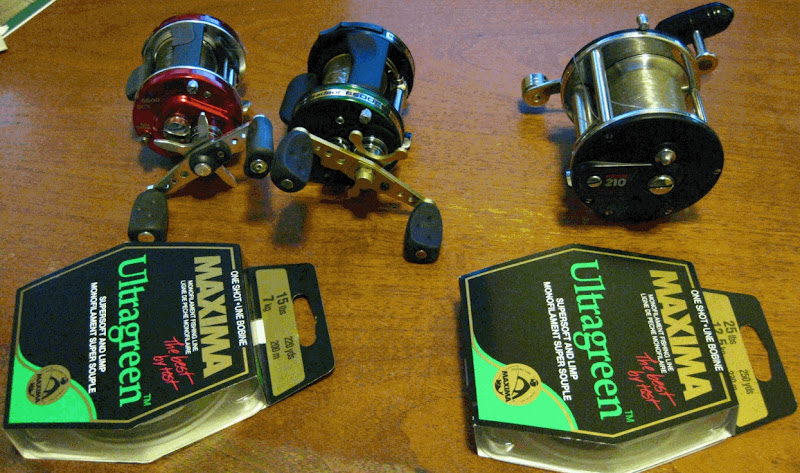
Jigging selection! "Tubber" will be happy to see a nice selection of Zzinger there. Couldn't resist trying some butterfly jigs.
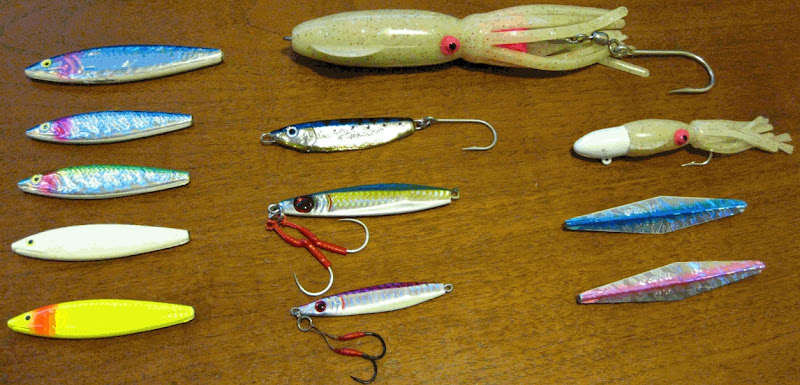
Selection of Coyote spoons. Hopefully IronNoggin's coyote mod works for me! So, do I need to change all these hooks out?
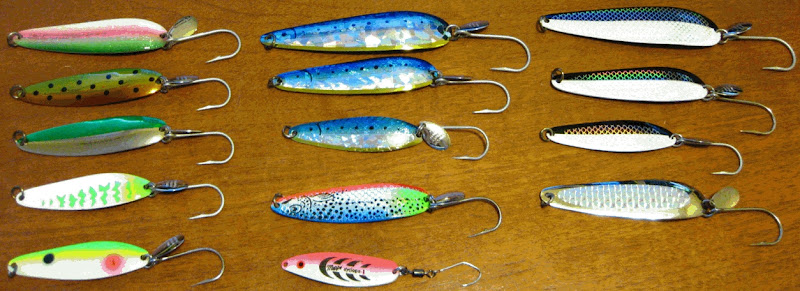
My bucktails, hoochies and flashers. These are the mini flashers. I figure with kayaking, probably can't work a full size flasher, and these would be mostly to add some action to the hoochies and bucktails. Probably only 3ft leader? then another 3ft and slip weight?
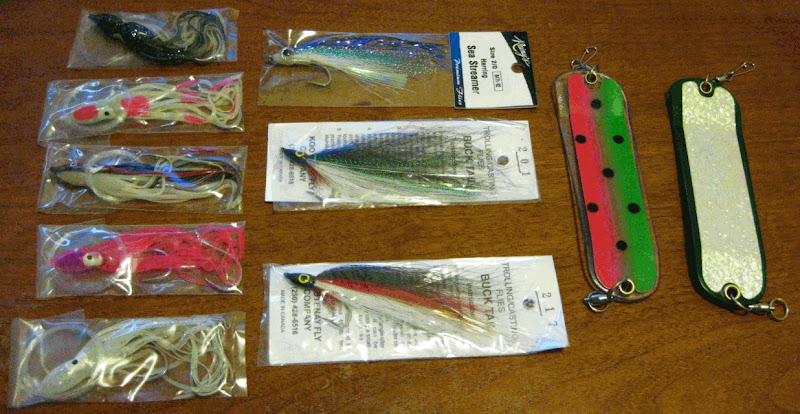
Finally, I hope someone can find this pic usefull. Shows what Mapster can do hilighting the recreational fishing grounds and chart 3670.
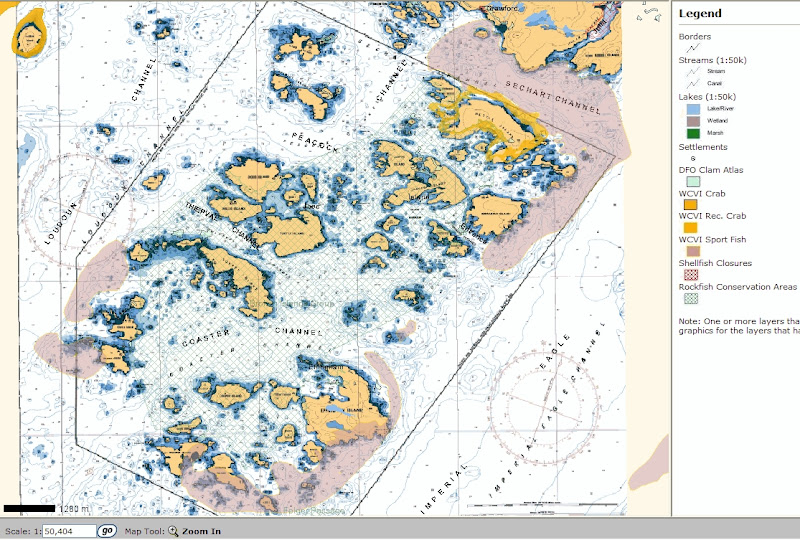
Thank you again to everyone on this forum. I've gained so much insight and knowledge that probably would have taken 10 to 20 years to pick up on my own. So.....Thank you!
Now.....I just wanna catch a salmon!..........and a halibut!..................and a snapper!.......................and a ling!
Trev
This is a continuation of my first post regarding a Kayak trip I'll be on in one week in the Broken Islands. (Look here if you're interested http://www.sportfishingbc.com/forum/topic.asp?TOPIC_ID=12875
First off, thank you to everyone who provided great ideas in the other post. As you can see from the photo's below, I've been hard at work studying the forums and putting my gear together.
I have a few questions though.
#1. You can see from the pic with the reels and line, that I have two reels strung with 15lb Maxima Ulragreen. Do you think 15 lb test will hold up for Coho, cod, Spring? and/or Halibut? I picked 15lb test because we're fishing from kayaks and I didn't want something I couldn't break off if I snagged bottom or hooked a monster. This is more a safety consideration than anything else. Also I can hold more line on the reel. After reading a post regarding line test that everyone is using, it seems most guys are on 20lb or 25lb test. So what I'm wondering is whether 15lb will be enough for 90% of what I'll hook. ie. Do I even have a chance of bringing in a 20lb or larger Spring.....in a KAYAK.....with 15lb test line.....with my girlfriend netting it?
#2. Assuming I have a chance bringing in a larger fish with 15lb test line....I really would love to catch a small halibut</u>. I've seen a photo of a halibut caught off Sail Rock in SW Broken Group and Salmon University talks about halibut in Coaster Channel. So can anyone confirm halibut within this area reachable by kayak? I would like to catch a small one (for obvious reasons!) and bought a 8oz B2 Triple Glow Squid to give it a shot. (See photo below) I figured NE of Effingham Island or South of Benson Island would be where I would try.
#3. About the Coyote spoons. Seems most people change the hooks out. With only a 15lb test and fishing form a kayak, I won't be hauling on the line too much. Do you think it's worth the bother changing all the hooks out under these conditions?
#4. What do you think the risk is of dragging a salmon beside your kayak? I'm thinking of when they are bleeding out? or when using a fish string to keep your catch? Will a seal come right up beside a kayak and take the fish? (Possibly flipping the kayak!) Should a guy just get it into the kayak as soon as possible and worry about the slime later? Don't even bleed it out?
#5. What are the risks of PSP Shellfish contamination in the Broken Islands? There are no closures, does that mean no risk? Safe to eat up?!?! Just want to make sure because it sounds a little scary! Getting paralyzed and all.
And finally, in an effort to contribute a bit to this site, I found the following website very helpfull, and kind of fun to fool around on. http://www.canbcdw.pac.dfo-mpo.gc.ca/ows/imf.jsp?site=mapster See the last photo below for an example of what this site can do. It shows fishing areas, crabbing areas, clams, shellfish closures, Rockfish conservation areas and even the charts. You can zoom in and get all the same detail as the original charts. This particular one is a little off, but you get the idea. The old salts will already know all these areas, but for those of us just starting, there is some good information there.
Photos</u>
My reels with line. The red one is an Ambassadeur 6600 BCX, the green is an Ambassadeur 6600C5 MAG-X and the black one was given to me for free by a nice guy at the fishing store and it's a Penn 210. Weighs a ton and haven't tried it out yet. Need to pull it apart and see how bad it looks.
Jigging selection! "Tubber" will be happy to see a nice selection of Zzinger there. Couldn't resist trying some butterfly jigs.
Selection of Coyote spoons. Hopefully IronNoggin's coyote mod works for me! So, do I need to change all these hooks out?
My bucktails, hoochies and flashers. These are the mini flashers. I figure with kayaking, probably can't work a full size flasher, and these would be mostly to add some action to the hoochies and bucktails. Probably only 3ft leader? then another 3ft and slip weight?
Finally, I hope someone can find this pic usefull. Shows what Mapster can do hilighting the recreational fishing grounds and chart 3670.
Thank you again to everyone on this forum. I've gained so much insight and knowledge that probably would have taken 10 to 20 years to pick up on my own. So.....Thank you!
Now.....I just wanna catch a salmon!..........and a halibut!..................and a snapper!.......................and a ling!
Trev


